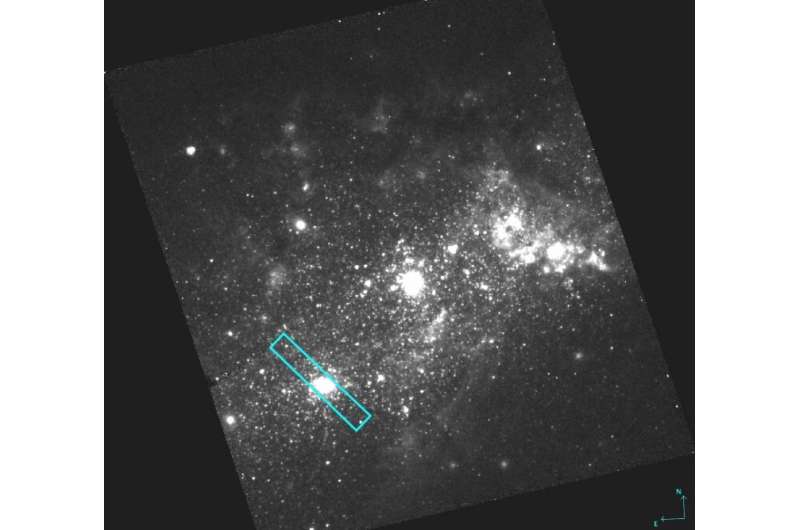October 4, 2022 report
Study investigates chemical composition of the young massive cluster NGC 1569-B

Using the Keck Observatory, astronomers from the Radboud University in the Netherlands and elsewhere have conducted spectroscopic observations of a young massive cluster known as NGC 1569-B. Results of the observational campaign, published September 23 on the arXiv pre-print server, yield important insights into the chemical composition of this cluster.
In general, young massive clusters (YMCs) are dense aggregates of young stars that form the fundamental building blocks of galaxies. Studying their chemical composition could provide essential information regarding stellar populations.
Estimated to be 15–25 million years old, NGC 1569-B is a YMC in the dwarf irregular galaxy NGC 1569, located some 6,000 light years away from the Earth. With a mass of about 440,000 solar masses, NGC 1569-B is more massive than any of the young clusters in the Milky Way or Large Magellanic Cloud (LMC). Such massive clusters are rare in our galaxy and even in the Local Group.
A group of astronomers led by Anastasia Gvozdenko investigated NGC 1569-B with the high-resolution echelle spectrometer (HIRES) on the Keck I 10-m telescope on Mauna Kea in Hawaii. The main aim of their study was to perform a detailed chemical abundance analysis of this cluster.
"We performed a high-resolution IL [integrated-light] spectrum analysis of the YMC NGC 1569-B. This is the first detailed abundance study of this YMC using the full optical wavelength range," the researchers wrote in the paper.
The observations found that NGC 1569-B is slightly metal-poor as its metallicity was measured to be about −0.77. It showcases alpha and the majority of the iron-peak element abundance ratios typical for Milky Way thick disk or LMC bar stars. What is noteworthy is that the cluster has a particularly high titanium abundance of approximately 0.49.
Furthermore, the results indicate that NGC 1569-B has a relatively high barium-to-iron abundance ratio. This could be caused by the contribution from massive stars, however no evidence supporting this theory has been found.
Another unexpectedly high abundance ratio was found to be scandium to iron. The authors of the paper are unable to explain this result at the moment, therefore further studies of the chemical composition of NGC 1569-B are required to find a plausible hypothesis.
Summing up the findings, the researchers noted that the chemical abundances of NGC 1569-B generally resemble those of another YMC that was the subject of recently published studies—NGC 1705-1.
"The composition of NGC 1569-B resembles the stellar populations of the YMC NGC 1705-1, located in a blue compact dwarf galaxy. The two YMCs agree with regard to alpha-elements and the majority of the iron-peak elements, except for Sc and Ba, which are extremely super-solar in NGC 1569-B—and higher than in any YMC studied so far," the astronomers concluded.
More information: Anastasia Gvozdenko, Søren S. Larsen, Michael A. Beasley, Jean Brodie, Chemical composition of the young massive cluster NGC 1569-B. arXiv:2209.11779v1 [astro-ph.GA], arxiv.org/abs/2209.11779
© 2022 Science X Network





















